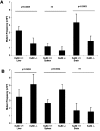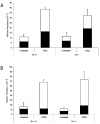Effect of Ku80 deficiency on mutation frequencies and spectra at a LacZ reporter locus in mouse tissues and cells
- PMID: 18941635
- PMCID: PMC2565499
- DOI: 10.1371/journal.pone.0003458
Effect of Ku80 deficiency on mutation frequencies and spectra at a LacZ reporter locus in mouse tissues and cells
Abstract
Non-homologous end joining (NHEJ) is thought to be an important mechanism for preventing the adverse effects of DNA double strand breaks (DSBs) and its absence has been associated with premature aging. To investigate the effect of inactivated NHEJ on spontaneous mutation frequencies and spectra in vivo and in cultured cells, we crossed a Ku80-deficient mouse with mice harboring a lacZ-plasmid-based mutation reporter. We analyzed various organs and tissues, as well as cultured embryonic fibroblasts, for mutations at the lacZ locus. When comparing mutant with wild-type mice, we observed a significantly higher number of genome rearrangements in liver and spleen and a significantly lower number of point mutations in liver and brain. The reduced point mutation frequency was not due to a decrease in small deletion mutations thought to be a hallmark of NHEJ, but could be a consequence of increased cellular responses to unrepaired DSBs. Indeed, we found a substantial increase in persistent 53BP1 and gammaH2AX DNA damage foci in Ku80-/- as compared to wild-type liver. Treatment of cultured Ku80-deficient or wild-type embryonic fibroblasts, either proliferating or quiescent, with hydrogen peroxide or bleomycin showed no differences in the number or type of induced genome rearrangements. However, after such treatment, Ku80-deficient cells did show an increased number of persistent DNA damage foci. These results indicate that Ku80-dependent repair of DNA damage is predominantly error-free with the effect of alternative more error-prone pathways creating genome rearrangements only detectable after extended periods of time, i.e., in young adult animals. The observed premature aging likely results from a combination of increased cellular senescence and an increased load of stable, genome rearrangements.
Conflict of interest statement
Figures






Similar articles
-
Paradoxical decrease in mutant frequencies and chromosomal rearrangements in a transgenic lacZ reporter gene in Ku80 null mice deficient in DNA double strand break repair.Mutat Res. 2003 Aug 28;529(1-2):51-8. doi: 10.1016/s0027-5107(03)00108-8. Mutat Res. 2003. PMID: 12943919
-
Collaboration of homologous recombination and nonhomologous end-joining factors for the survival and integrity of mice and cells.Genes Dev. 2004 Jun 1;18(11):1293-304. doi: 10.1101/gad.1209204. Genes Dev. 2004. PMID: 15175261 Free PMC article.
-
Deletion of Ku80 causes early aging independent of chronic inflammation and Rag-1-induced DSBs.Mech Ageing Dev. 2007 Nov-Dec;128(11-12):601-8. doi: 10.1016/j.mad.2007.08.006. Epub 2007 Sep 12. Mech Ageing Dev. 2007. PMID: 17928034 Free PMC article.
-
Mechanisms of DNA double strand break repair and chromosome aberration formation.Cytogenet Genome Res. 2004;104(1-4):14-20. doi: 10.1159/000077461. Cytogenet Genome Res. 2004. PMID: 15162010 Review.
-
Genomic instability, aging, and cellular senescence.Ann N Y Acad Sci. 2004 Jun;1019:245-55. doi: 10.1196/annals.1297.041. Ann N Y Acad Sci. 2004. PMID: 15247023 Review.
Cited by
-
Deletion of individual Ku subunits in mice causes an NHEJ-independent phenotype potentially by altering apurinic/apyrimidinic site repair.PLoS One. 2014 Jan 23;9(1):e86358. doi: 10.1371/journal.pone.0086358. eCollection 2014. PLoS One. 2014. PMID: 24466051 Free PMC article.
-
Effects of the scid mutation on X-ray-induced deletions in the brain and spleen of gpt delta mice.Genes Environ. 2020 May 24;42:19. doi: 10.1186/s41021-020-00158-y. eCollection 2020. Genes Environ. 2020. PMID: 32489484 Free PMC article.
-
DNA damage in normally and prematurely aged mice.Aging Cell. 2013 Jun;12(3):467-77. doi: 10.1111/acel.12071. Epub 2013 Apr 24. Aging Cell. 2013. PMID: 23496256 Free PMC article.
-
PARP1 suppresses homologous recombination events in mice in vivo.Nucleic Acids Res. 2010 Nov;38(21):7538-45. doi: 10.1093/nar/gkq624. Epub 2010 Jul 21. Nucleic Acids Res. 2010. PMID: 20660013 Free PMC article.
-
SIRT1 and LSD1 competitively regulate KU70 functions in DNA repair and mutation acquisition in cancer cells.Oncotarget. 2016 Aug 2;7(31):50195-50214. doi: 10.18632/oncotarget.10328. Oncotarget. 2016. PMID: 27384990 Free PMC article.
References
-
- Burma S, Chen BP, Chen DJ. Role of non-homologous end joining (NHEJ) in maintaining genomic integrity. DNA Repair (Amst) 2006;5:1042–1048. - PubMed
-
- Lieber MR, Yu K, Raghavan SC. Roles of nonhomologous DNA end joining, V(D)J recombination, and class switch recombination in chromosomal translocations. DNA Repair (Amst) 2006;5:1234–1245. - PubMed
-
- Lieber MR, Karanjawala ZE. Ageing, repetitive genomes and DNA damage. Nat Rev Mol Cell Biol. 2004;5:69–75. - PubMed
Publication types
MeSH terms
Substances
Grants and funding
LinkOut - more resources
Full Text Sources
Molecular Biology Databases
Research Materials

